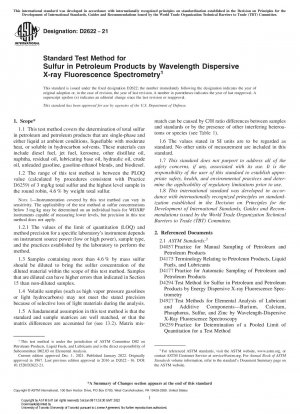ASTM D2622-21
Standard Test Method for Sulfur in Petroleum Products by Wavelength Dispersive X-ray Fluorescence Spectrometry
- Standard No.
- ASTM D2622-21
- Release Date
- 2021
- Published By
- American Society for Testing and Materials (ASTM)
- Latest
- ASTM D2622-21
- Scope
- 1.1 This test method covers the determination of total sulfur in petroleum and petroleum products that are single-phase and either liquid at ambient conditions, liquefiable with moderate heat, or soluble in hydrocarbon solvents. These materials can include diesel fuel, jet fuel, kerosene, other distillate oil, naphtha, residual oil, lubricating base oil, hydraulic oil, crude oil, unleaded gasoline, gasoline-ethanol blends, and biodiesel. 1.2 The range of this test method is between the PLOQ value (calculated by procedures consistent with Practice D6259) of 3 mg/kg total sulfur and the highest level sample in the round robin, 4.6 % by weight total sulfur. NOTE 1—Instrumentation covered by this test method can vary in sensitivity. The applicability of the test method at sulfur concentrations below 3 mg ⁄kg may be determined on an individual basis for WDXRF instruments capable of measuring lower levels, but precision in this test method does not apply. 1.2.1 The values of the limit of quantitation (LOQ) and method precision for a specific laboratory’s instrument depends on instrument source power (low or high power), sample type, and the practices established by the laboratory to perform the method. 1.3 Samples containing more than 4.6 % by mass sulfur should be diluted to bring the sulfur concentration of the diluted material within the scope of this test method. Samples that are diluted can have higher errors than indicated in Section 15 than non-diluted samples. 1.4 Volatile samples (such as high vapor pressure gasolines or light hydrocarbons) may not meet the stated precision because of selective loss of light materials during the analysis. 1.5 A fundamental assumption in this test method is that the standard and sample matrices are well matched, or that the matrix differences are accounted for (see 13.2). Matrix mismatch can be caused by C/H ratio differences between samples and standards or by the presence of other interfering heteroatoms or species (see Table 1). 1.6 The values stated in SI units are to be regarded as standard. No other units of measurement are included in this standard. 1.7 This standard does not purport to address all of the safety concerns, if any, associated with its use. It is the responsibility of the user of this standard to establish appropriate safety, health, and environmental practices and determine the applicability of regulatory limitations prior to use. 1.8 This international standard was developed in accordance with internationally recognized principles on standardization established in the Decision on Principles for the Development of International Standards, Guides and Recommendations issued by the World Trade Organization Technical Barriers to Trade (TBT) Committee.
ASTM D2622-21 Referenced Document
- ASTM D4057 Standard Practice for Manual Sampling of Petroleum and Petroleum Products
- ASTM D4175 Standard Terminology Relating to Petroleum Products, Liquid Fuels, and Lubricants*, 2023-07-01 Update
- ASTM D4177 Standard Practice for Automatic Sampling of Petroleum and Petroleum Products
- ASTM D4294 Standard Test Method for Sulfur in Petroleum Products by Energy-Dispersive X-Ray Fluorescence Spectroscopy
- ASTM D4927 Standard Test Methods for Elemental Analysis of Lubricant and Additive Components8212;Barium, Calcium, Phosphorus, Sulfur, and Zinc by Wavelength-Dispersive X-Ray Fluorescence Spectroscopy
- ASTM D6259 Standard Practice for Determination of a Pooled Limit of Quantitation
- ASTM D6299 Standard Practice for Applying Statistical Quality Assurance and Control Charting Techniques to Evaluate Analytical Measurement System Performance*, 2023-07-01 Update
- ASTM D7343 Standard Practice for Optimization, Sample Handling, Calibration, and Validation of X-ray Fluorescence Spectrometry Methods for Elemental Analysis of Petroleum Products and Lubricants
- ASTM E29 Standard Practice for Using Significant Digits in Test Data to Determine Conformance with Specifications
ASTM D2622-21 history
- 2021 ASTM D2622-21 Standard Test Method for Sulfur in Petroleum Products by Wavelength Dispersive X-ray Fluorescence Spectrometry
- 2016 ASTM D2622-16 Standard Test Method for Sulfur in Petroleum Products by Wavelength Dispersive X-ray Fluorescence Spectrometry
- 2010 ASTM D2622-10 Standard Test Method for Sulfur in Petroleum Products by Wavelength Dispersive X-ray Fluorescence Spectrometry
- 2008 ASTM D2622-08 Standard Test Method for Sulfur in Petroleum Products by Wavelength Dispersive X-ray Fluorescence Spectrometry
- 2007 ASTM D2622-07 Standard Test Method for Sulfur in Petroleum Products by Wavelength Dispersive X-ray Fluorescence Spectrometry
- 2005 ASTM D2622-05 Standard Test Method for Sulfur in Petroleum Products by Wavelength Dispersive X-ray Fluorescence Spectrometry
- 2003 ASTM D2622-03 Standard Test Method for Sulfur in Petroleum Products by Wavelength Dispersive X-ray Fluorescence Spectrometry
- 1998 ASTM D2622-98 Standard Test Method for Sulfur in Petroleum Products by Wavelength Dispersive X-ray Fluorescence Spectrometry
- 1994 ASTM D2622-94 Standard Test Method for Sulfur in Petroleum Products by X-Ray Spectrometry
- 1992 ASTM D2622-92e1 Standard Test Method for Sulfur in Petroleum Products by X-Ray Spectrometry
- 1987 ASTM D2622-87e1 Standard Test Method for Sulfur in Petroleum Products by X-Ray Spectrometry
